|
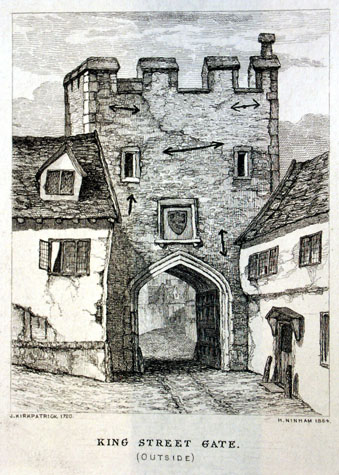
[1] The south or outer side of the gate. The etching was made by
Henry Ninham in 1864 from a drawing by John Kirkpatrick [Norwich
Castle Museum and Art Gallery 1954.138, Todd 5, Norwich, 116a]
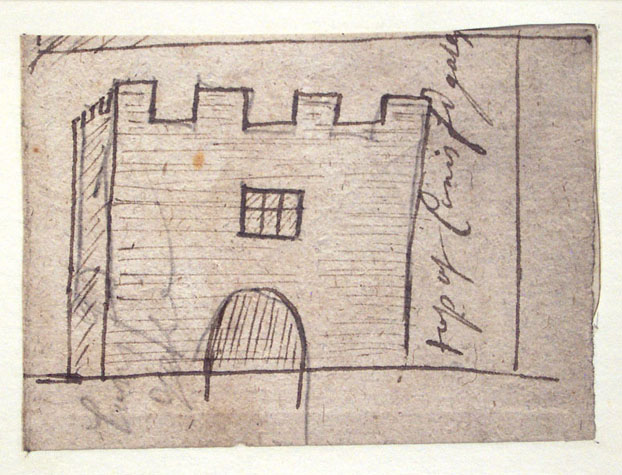
[2] Sketch of Conisford Gate c.1720 by John Kirkpatrick. [Norwich
Castle Museum and Art Gallery1894.76.1697: F]
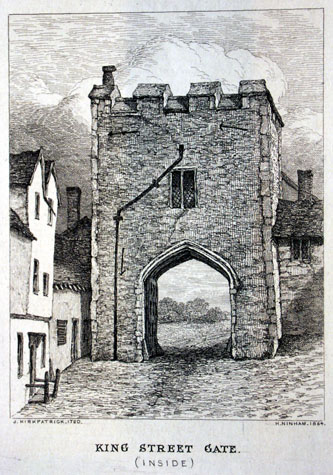
[3] The interior or north side of the gate from a drawing by John
Kirkpatrick redrawn and etched by Henry Ninham in 1864. [Norwich
Castle Museum and Art Gallery 1954.138, Todd 5, Norwich, 116b]
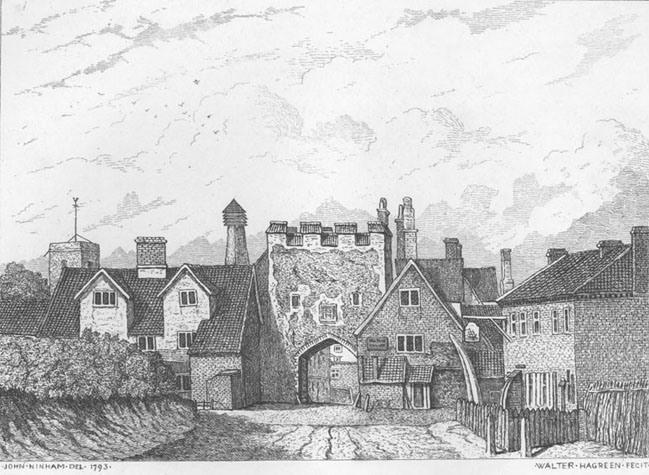
[4] The exterior of Conisford Gate in 1793 by John Ninham.
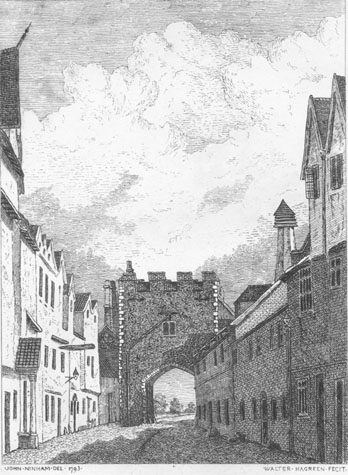
[5] The interior of Conisford Gate in 1793 by John Ninham.
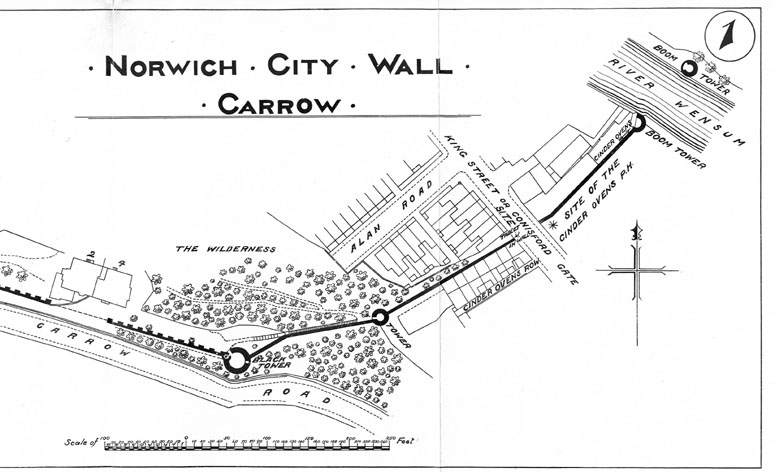
[6] Map of the wall on either side of the gate published in the
report of 1910.
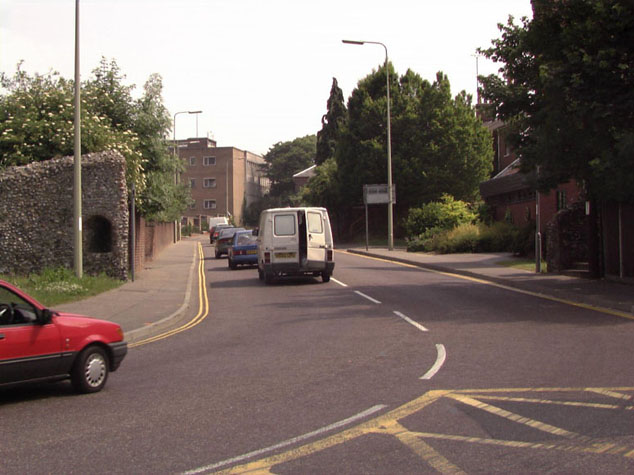
[7] View of the site of the gate from the north, from the city side,
with the surviving wall on the left running down to the river and the Boom
Towers.
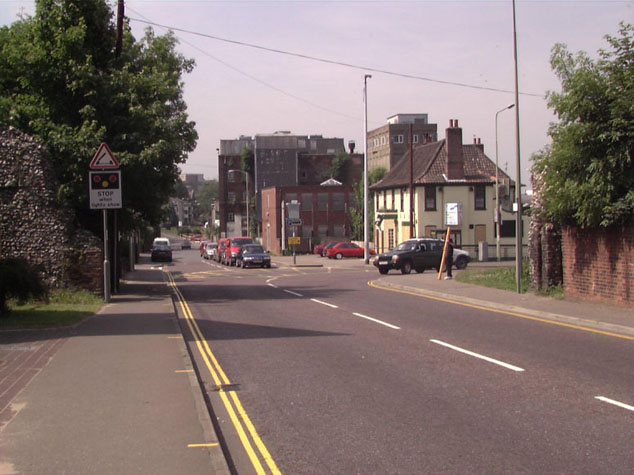
[8] View of the site of the gate from the south, from outside the
city, looking down King Street. The surviving wall to the left runs up
the hill to the lower tower in the Wilderness.
|
General description
John Kirkpatrick's pen and ink sketch of the top of the gate, drawn
about 1720, shows four battlements to the front, and three along the side
to the left of the gate.
[NCM Fitch Collection 1894.76.1697, 16x22] There is one small window to
the inner face and a small rounded arch is shown immediately below it.
[2]
Engravings of the gate by Henry Ninham in 1864 [1] copy Kirkpatrick's
depiction of the gate in 1720.
[NCM Todd Collection vol. II, box 5, page 116] The views show a compact
solid gateway with a relatively narrow archway that appears to be
constructed in stone. On the outer side, immediately above the apex
of the arch, was a square coat of arms and the first-floor chamber
over the gateway was lit by two small, widely spaced square-headed loops.
Abutting to the left or west of the gate along the outside line of the
wall and built against it was a dilapidated house, and to the right
there was a two-storey, timber-framed and jettied cottage running along
the street but apparently with its north gable hard against the wall.
The flanking walls are not visible.
The comparable view of the gate from inside the city shows a two-light,
square-headed mullion window to the upper chamber.
[3] A rainwater pipe emerging from the wall immediately above the window
suggests that the roof of the tower was set low behind high parapets.
A low building abutting the gate at right angles to the east obscures
the wall running down towards the river but there is the suggestion of
a sloping roof or parapet wall for the steps down from the chamber on to
the wall walk. To the west the house visible on the outer view appears
to be built against and over the wall.
John Ninham's depiction of the south or outside of the gate in 1792
[published by Fitch in 1861] shows the cottages on either side, that to
the west or left having tall dormer windows and a distinctive outshut to
the front on the street side.
[4] Against the west side of the gate is a slope that is almost
certainly a steep parapet protecting the steps leading down from the
gate chamber to the wall walk.
The view from inside the city [5] shows a gate with four metal braces,
three at the top, and one down the left-hand side.
[NCM Fitch Collection, 1758.76.94] The archway appears to be formed in
brick and there are stone quoins at the north-west and north-east angles
of the gate. Buildings abut the gateway to the left and right, and
again the walls flanking the gate are not visible.
Documentary evidence
The gates were first mentioned between 1175 and 1186 in the Liber
Albus, and the
Register of St. Benet of Holme, respectively. In the latter the
gates were mentioned as 'ecclesiam Sancti Petri in Cuninesford prope
portem civitatis Norwici.'
[SMR NF26131, citing St. Benet of Holme]
Documents indicate that the Conisford Gate was rebuilt and presumably
reinforced in the 14th century under the auspices of Richard Spynk.
[Extract from The Old Free Book, Hudson & Tingey, vol. II,
pages 216-22] The
Agistment for the Walls of 1451 and 1481 show that South Conesford
ward was responsible for repairs to this gate.
[Liber Albus, f. 177; Hudson & Tingey, vol. II, pages 313-5]
The Treasurer's Accounts for 1385-6 record that 35s 9d was
spent 'making the ditch at Conesford Gates'.
[Hudson & Tingey, vol. II, page 48]
In 1643 the gates were rampired with earth as a precaution during
the civil war.
[Blomefield, page 386]
In 1664 part of the gate collapsed, as the house of one Isaac Wynn
was ruined on account of its fall.
[Fitch, page 4] The gate was presumably rebuilt or repaired as it
was finally pulled down in 1794.
[Fitch, page 4] An advertisement in the Norfolk Chronicle in March
that year asks for people to contract to undertake its removal.
[cited in full in Fitch, page 4]
Map evidence
Historic maps provide clear evidence for the precise position of the
gate and also provide clues to the overall size of the gate. The map by
Hochstetter published in 1789, just before the gate was demolished, shows
the gate and the walls and buildings on either side. The map shows that
the gate was set back with the front face almost in line with the walls.
Most of the other gates around the city project forward beyond the wall
line, being at least to some extent, built over the ditch.
The first edition of the Ordnance Survey map published in 1885 [Sheet
LXIII.15.15] not only shows how narrow the street was but shows that the
buildings drawn by Ninham nearly a hundred years earlier were still
standing. Together, the evidence from the maps and the view by Ninham
fix the position of the lost gate accurately.
[6]
The flint walls on either side of King Street survive right up to the
edge of the pavements.
[35-01 Map] The space here now seems very narrow .. the surviving
sections of the walls are just 11 metres apart. However, the 1885 map
shows that the street was even narrower at that stage. The implication
is that the whole gate, not just the archway of the gate, was about the
same width as the modern tarmac road excluding the pavements. The gate
was about 8 metres wide and 11 metres high and the archway was less than
4 metres wide and 3 metres high to the springing of the arch which was
about 4.5 metres high to the apex. As a comparison... the tower at Bull
Close Road is 6.5 metres wide and 8 metres high though it has lost its
parapet.
Present state: archaeology. conservation and potential excavations
There is very heavy traffic through this part of King Street, using
the Carrow Bridge and there would be, almost certainly, no chance of
conducting an excavation on this site.
[7 & 8] Contractors for any trench work in
the immediate area for services should be aware of how sensitive and
important this site is. Archaeological evidence could fix the position
and dimensions of the gate precisely. More important, foundations and
earthworks might not only determine the date of the earliest gate on this
site but might disentangle a series of alterations that culminated with
the gate as drawn by Ninham. Evidence from excavations elsewhere, suggest
that the lower parts of the structure of the gate and the ditch and any
bridge over the ditch can survive. This is, in part, because the
foundations are built deep down into the ditch and because the modern
ground level is, in many areas considerably higher than the medieval
level providing an element of protection.
If the Boom Towers and the Black Tower are to be promoted as tourist
attractions then some form of information panel or at least an
identification sign for the site of the gate is recommended.
BIBLIOGRAPHY:
Blomefield, Francis, An Essay Towards the Topographical History of the
County of Norfolk, vol. III: The History and County of Norwich Part I
(London: W. Bulmer, 1806)
Buckler, J., 'Conisford Gate, Norwich'
Collins, Arthur E., The Walls of Norwich (City and County of Norwich,
Norwich: Jarrold & Sons, 1910)
Fitch, Robert, Views of the Gates of Norwich made in the years 1792-3 by
the Late John Ninham (Norwich: Cundall, Miller, and Leavins, 1861)
Hudson, William, and Tingey, John C., The Records of the City of Norwich,
vol. II (Norwich & London: Jarrold & Sons, 1910)
Pococke, Edward, 'Sixteen Drawings of the Gates of Norwich', NCM
1955.219:IN
DOCUMENTARY REFERENCES:
N.R.O. MF/RO 29/3 f. 177 (Liber Albus)
Register of St. Benet of Holme, (Norwich Records Society, 1932)
Norfolk Chronicle, March 3rd, 1794
ARCHAEOLOGICAL REPORTS:
SMR NF26131
HISTORIC ILLUSTRATIONS:
In the Norwich Castle Museum and Art Gallery:
Harcourt, Bosworth, 'King St Gates', NCM 1922.135. BH46: INT
Harcourt, Bosworth, 'City Tower, King St Gates', NCM 1922.135. BH
92:INT
Kirkpatrick, John, c. 1720, 'Top of Conisford Gate', NCM Fitch Collection
1894.76.1697, 16x22
Ninham, Henry, 1864, from John Kirkpatrick, 1720, 'Conesford (King
Street) Gate', NCM Todd Collection vol. II, box 5, page 116
Ninham, John, 1792, 'Conesford Gate, Inside', NCM Fitch Collection
1757.76.94
Ninham, John, 1792, 'Conesford Gate, Outside', NCM Fitch Collection,
1758.76.94
|
